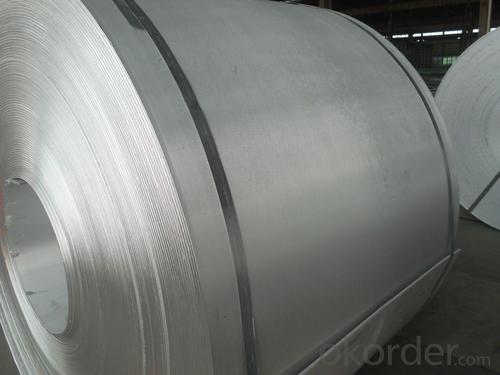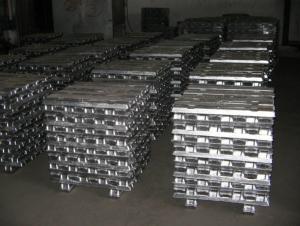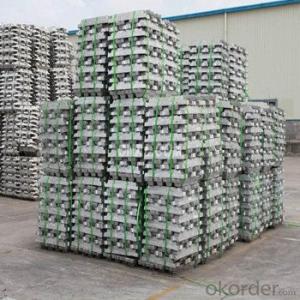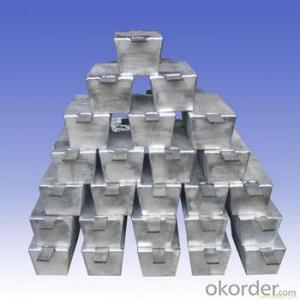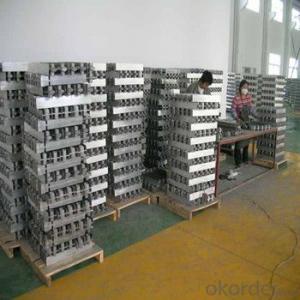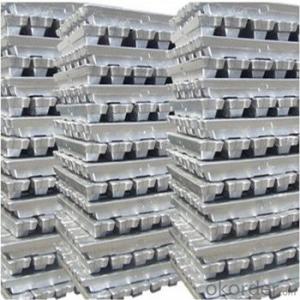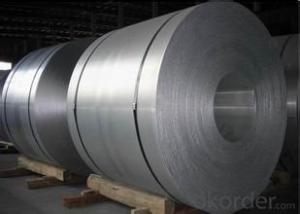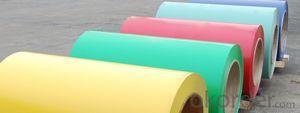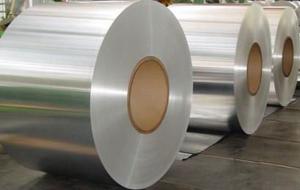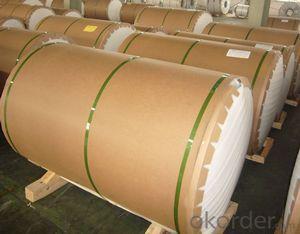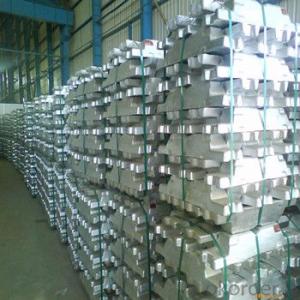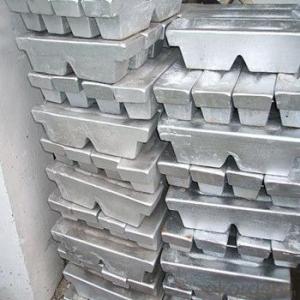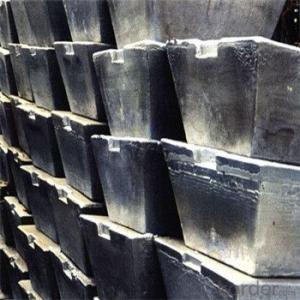Aluminum casting master coil AA1070 iqual to P1020 for melt
- Loading Port:
- Tianjin
- Payment Terms:
- TT OR LC
- Min Order Qty:
- 200 m.t.
- Supply Capability:
- 5000 m.t./month
OKorder Service Pledge
OKorder Financial Service
You Might Also Like
Aluminium alloys (or aluminum alloys; see spelling differences) are alloys in which aluminium (Al) is the predominant metal. The typical alloying elements are copper, magnesium, manganese, silicon, tin and zinc. There are two principal classifications, namely casting alloys and wrought alloys, both of which are further subdivided into the categories heat-treatable and non-heat-treatable. About 85% of aluminium is used for wrought products, for example rolled plate, foils and extrusions. Cast aluminium alloys yield cost-effective products due to the low melting point, although they generally have lower tensile strengths than wrought alloys. The most important cast aluminium alloy system is Al–Si, where the high levels of silicon (4.0–13%) contribute to give good casting characteristics. Aluminium alloys are widely used in engineering structures and components where light weight or corrosion resistance is required
Specification:
Alloy: AA1070
Temper: F
Thickness:6mm—100mm
Width: 900mm—2300mm (Can be slitted)
Inner Diameter: 508MM
Coil Weight: AS REQUIRED
Application: MELT FOR LINGOTE TO MAKE ALUMINUM COIL O PLATE
Features:
1. Excellent quality of products
2. Quick delivery
3. Best service to clients
4. BV,SGS avalible
5. No buckle o waveness
6. Tension leveling
7. Certificate of Origin
8. Form A,E,F
Packaging Detail:
Carton ,Wooden pallet with plastic protection packing ,standard seaworthy packing or as your request.
Production Capacity:
Annual Production capacity of 600,000 tons.
Products are exported to United States, Canada, U.A.E, Brazil, Mexico,Thailand, Vietnam, Nigeria etc, over 100 countries and regions all over the world.
Production Line:
CNBM aluminum production base is comprised of 18 aluminum annealers, 10 coil and foil mills, 4 continuous production lines, 2 hot rolling production line and 3 prepainted lines.
FAQ:
1. What is the form of payment?
Normally 30% TT, 100% L
/C AT SIGHT
2. Type of quotation?
FOB, CFR, CIF
3. Port of loading?
Any port in China
4. Delivery time?
30 day after client’s deposit
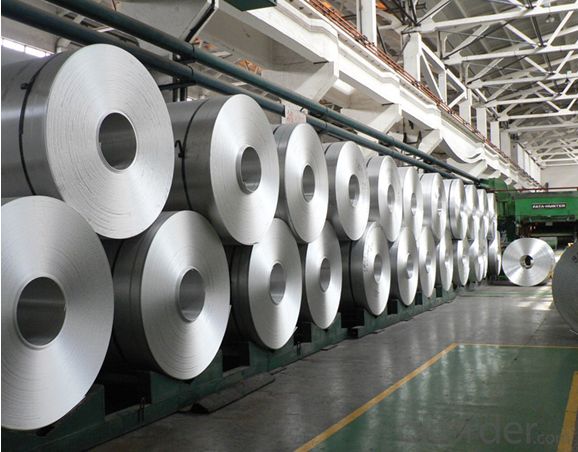
- Q: How are aluminum ingots used in the production of lighting fixtures?
- Aluminum ingots play a crucial role in the production of lighting fixtures due to their unique properties and versatility. Firstly, aluminum is lightweight yet highly durable, making it an ideal material for manufacturing various components of lighting fixtures, such as the body, base, or frame. Its lightweight nature allows for easier installation and transportation, while its durability ensures the longevity of the fixture. Moreover, aluminum has excellent thermal conductivity, which is essential for lighting fixtures as it helps dissipate heat generated by the bulbs. This property allows the fixture to remain cool and prevents overheating, ensuring the safety and efficiency of the lighting system. In addition, aluminum ingots can be easily molded into different shapes and sizes, enabling the production of intricate and aesthetically pleasing lighting fixtures. This flexibility in design allows manufacturers to create a wide range of styles, from sleek and modern to classic and ornate, catering to various consumer preferences. Furthermore, aluminum is highly corrosion-resistant, which is particularly important for lighting fixtures that may be exposed to outdoor elements or high levels of moisture. This property ensures that the fixture remains intact and maintains its appearance, even under harsh conditions. Lastly, aluminum ingots are also environmentally friendly, as they can be easily recycled and have a low carbon footprint compared to other materials. This makes aluminum an attractive choice for lighting fixture manufacturers who prioritize sustainability and want to reduce their environmental impact. Overall, aluminum ingots are indispensable in the production of lighting fixtures due to their lightweight, durable, and thermally conductive properties, as well as their versatility in design and environmental friendliness.
- Q: What industries use aluminum ingots?
- The industries that commonly use aluminum ingots include automotive, aerospace, construction, packaging, and electrical industries.
- Q: What are the basic equipments for the production of aluminium ingots?
- Pay attention to points can also be added on the basis of: mixing equipment, feeding equipment, sorting equipment, online degassing, etc..
- Q: How is aluminum ingot different from aluminum billet?
- Aluminum ingot and aluminum billet are both forms of aluminum metal, but they differ in terms of their shape, size, and manufacturing process. Aluminum ingot is typically produced through a primary aluminum production process called smelting. It is a large rectangular block or slab of solid aluminum with a standardized shape and size. The ingot is usually obtained by casting molten aluminum into a mold and allowing it to cool and solidify. Aluminum ingots are commonly used as raw materials for further processing, such as rolling, extrusion, or forging, to produce various aluminum products. On the other hand, aluminum billet is a semi-finished product that is often derived from aluminum ingots. Billets are usually obtained by heating and continuously casting molten aluminum into a cylindrical shape and then allowing it to cool and solidify. Unlike ingots, billets have a smaller cross-sectional area and a longer length. They are commonly used as starting material for extrusion processes, where they are heated and forced through a die to produce complex shapes like rods, bars, profiles, or tubes. In summary, while both aluminum ingots and aluminum billets are made of the same material, their differences lie in their shape, size, and purpose. Ingots are large rectangular blocks used as raw materials for further processing, while billets are smaller cylindrical shapes used as starting material for extrusion processes.
- Q: Aluminum scrap and aluminum ingot in the intermediate frequency aluminum furnace, which is more energy saving?
- Tons of power consumption is basically the same!Theoretically, the aluminum ingot saves electricity.
- Q: Can aluminum ingots be used in 3D printing?
- Yes, aluminum ingots can be used in 3D printing. Aluminum is a commonly used material in additive manufacturing due to its lightweight, high strength, and excellent thermal conductivity. However, instead of directly using aluminum ingots, a process called powder bed fusion, specifically selective laser melting (SLM) or electron beam melting (EBM), is utilized. In this process, fine aluminum powder is spread in thin layers and selectively melted by a laser or electron beam, layer by layer, to create the desired 3D object. This allows for the production of complex geometries and precise parts with high strength and accuracy.
- Q: What are the quality standards for aluminum ingots?
- The quality standards for aluminum ingots typically include factors such as chemical composition, purity levels, physical properties like density and conductivity, as well as visual appearance and surface defects. These standards ensure that the aluminum ingots meet specific requirements for various industries and applications.
- Q: How are aluminum ingots used in the production of window frames?
- Aluminum ingots are melted down and formed into extruded profiles, which are then cut and assembled to create window frames. The ingots provide the raw material necessary for the manufacturing process and ensure the frames are lightweight, durable, and corrosion-resistant.
- Q: How are aluminum ingots used in the automotive industry?
- Aluminum ingots are used in the automotive industry primarily for the production of lightweight components, such as engine blocks, cylinder heads, and body panels. This helps to improve fuel efficiency and overall vehicle performance, while also reducing emissions. Additionally, aluminum ingots are utilized in the manufacturing of transmission cases, suspension systems, and other structural parts, contributing to the overall strength and durability of vehicles.
- Q: Is it harmful to the human body to refine ingots from waste capacitors?
- (the electrolyte in the battery is strong sulfuric acid) and whether it causes sterility depends on the composition of the electrolyte. The working electrolyte has three components
Send your message to us
Aluminum casting master coil AA1070 iqual to P1020 for melt
- Loading Port:
- Tianjin
- Payment Terms:
- TT OR LC
- Min Order Qty:
- 200 m.t.
- Supply Capability:
- 5000 m.t./month
OKorder Service Pledge
OKorder Financial Service
Similar products
Hot products
Hot Searches
Related keywords


